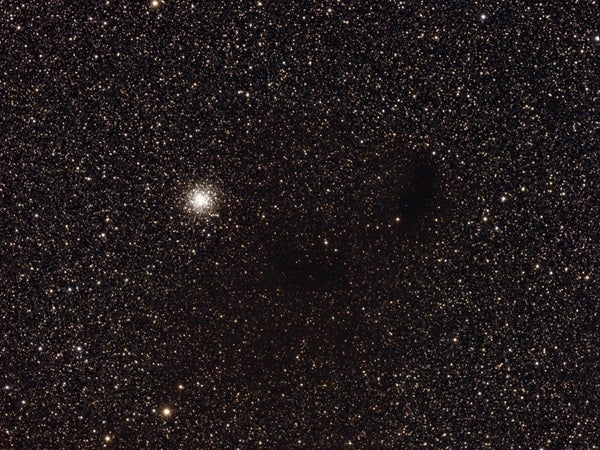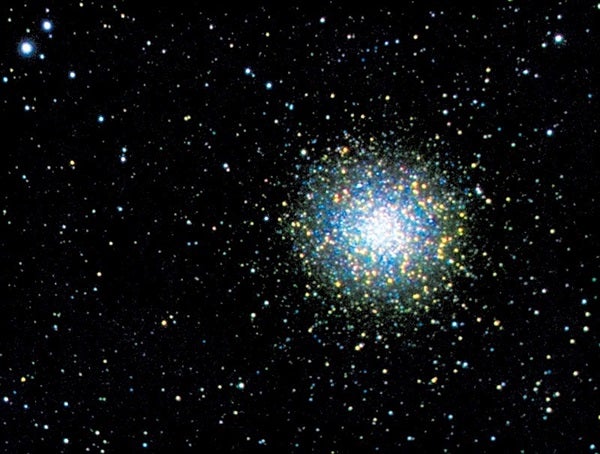Between the stars Altair (Alpha [α] Aquilae) and Antares (Alpha Scorpii) and just west of the Milky Way’s stream lies a large asymmetrical hexagon of half a dozen faint stars that outline the constellation Ophiuchus.
The ancient Greeks saw Ophiuchus as embodying Asclepius, the god of medicine. According to legend, Asclepius once killed a snake with his staff. But a second snake brought the first back to life using mystical herbs. Witnessing this, Asclepius began using those same herbs on people to bring them back from the dead.
To commemorate his healing powers, Asclepius was placed in the sky as Ophiuchus the Serpent-bearer. He is depicted with the serpent’s head, Serpens Caput, and tail, Serpens Cauda, in either hand.
For backyard astronomers, Ophiuchus is best known as being home to 24 globular star clusters — more than any other constellation except Sagittarius. This month, let’s visit four of Ophiuchus’ globulars.
We’ll begin with the brightest two, M10 and M12. Both lie just south of the hexagon’s center. To find M10, first locate the stars that form the southern boundary of Ophiuchus, just north of the head of Scorpius. The line kinks a little to the south in the middle, to the star Zeta (ζ) Ophiuchi. Glance 6° — about one field of view — northeast of Zeta for 5th-magnitude 23 Ophiuchi. Look for the soft, circular glow of M10 2.5° northeast of 23 and 1° west of neighboring 5th-magnitude 30 Ophiuchi.
Once you locate M10, shift your attention toward the northwest edge of the field without changing your binoculars’ aim. Can you see another circular patch? That’s M12. Both are evident through most binoculars, with M10 shining at magnitude 6.4 and M12 reaching magnitude 7.7.
Messier discovered M10 and M12 just a day apart in late May 1764. In both cases, he referred to his new finds as “nebula[e] without stars.” That pretty much mirrors our view through binoculars. Each looks like a tiny cotton ball floating among the stars. But there is so much more there. Globular clusters are huge spherical agglomerations of 100,000 or more of the oldest stars known. The stars in M10 are estimated to be 11.4 billion years old, while those in M12 are a billion years older still.
It is interesting to compare the two, since both are in the same field of view. At first glance, they look identical, but the discerning eye can see subtle differences. M10 appears slightly brighter and slightly larger than its neighbor. Notice also that M10 shows a more prominent central core than M12. That’s due in part to their differences in stellar density. M10’s stellar concentration is rated Class VII on the Shapley-Sawyer 12-point globular cluster concentration scale. On this scale, the lower the Roman numeral, the higher the cluster’s central concentration. M12 is rated Class IX. Through giant binoculars, such as my 25x100s, each shows a graininess, as if on the verge of resolution.
Messier also discovered globular cluster M9 in May 1764. M9 is found 3.5° southeast of Sabik (Eta [η] Ophiuchi), along the constellation’s southern boundary. M9 appears smaller and a full magnitude fainter than M10 and M12. That’s thanks to all the intervening clouds of interstellar dust. M9 is Class VIII, with a prominent central core that helps it to stand out.
Finally, aim about two-thirds of the way between Sabik and Cebalrai (Beta [β] Ophiuchi) along the hexagon’s eastern side. There, you will find M14, just as Messier did when he discovered it June 1, 1764. Like M9, when we look toward M14, we are seeing it through obscuring clouds of interstellar dust. That diminishes its brightness by two full magnitudes to a challenging 8th magnitude. Had we a clear view, M14 would outshine M9, M10, and M12, even though it is the most distant of the four. Like M9, M14 is rated Class VIII on the Shapley–Sawyer scale. Through most binoculars, it looks like a small blur of light hidden in a field rich in stars.
I welcome your questions, comments, and suggestions for future topics. Contact me through my website, philharrington.net. Until next month, remember that two eyes are better than one.











